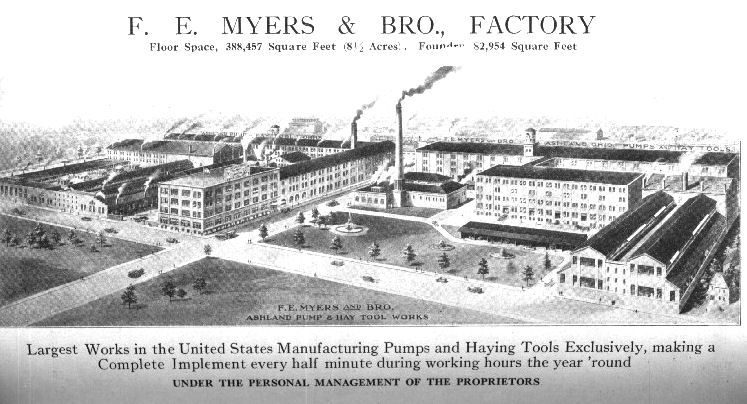How do paintings from an art-filled, Ohio home become the core of the only European Old Masters museum collection in the Orlando area?
The story began in 1870. Family patriarch, Francis Eunoch Myers, arrived in Ashland, OH to work as a clerk in a dry goods store on Main Street. Barely a decade later, he and his younger brother Philip Andrews started a pump factory, and the rest is Ashland history.
By the end of the first decade of the 20th century, F. E. Myers and Brother Co. had multiple plants. They produced more than 175,000 pumps a year and shipped to about 30,000 dealers around the world, making them the largest industry in town and the main employer. With this financial success came a taste for fine furnishings and the arts. In 1897, Eunoch built a house on Center Street in celebration of his silver wedding anniversary, and it transformed into a treasure chest. Described by local newspapers as “a palace,” everything in it was one-of-a-kind: from glass-paneled doors to mirrored walls, frescoed ceilings to paintings, rugs, and tapestries. The house quickly became the center of Ashland society life.
Industry mingled with music for Eunoch’s five children (one of Ashland’s very first organs was installed in their house) and religious devotion with civic mindedness. For this next generation — and especially for son John Clement Myers — a knowledge of art and a passion for collecting became a way of life, as did a different type of sharing with the Ashland community.

Starting in the late 1930s, nature lovers were welcome to wander through the extraordinary flower garden behind Myers’ house. Built on the model of English gardens and surrounded by a canopy of oaks and maples, the garden’s flora meandered between sculpted shrubbery and shallow pools filled with Koi. There was even a seasonal printed brochure available, describing the various types of plants and flowers (which one year included some 6,000 tulips) and their locations. The garden was also the site of community events. Graduates of Ashland High School would receive their diplomas on a makeshift stage, and the school choir, band and orchestra, and even the Ashland Symphony, would often perform there.
Myers clearly liked to host his fellow Ashland residents, and not just in the garden. In the years following World War II, if you were a student at Ashland College and wanted to experience European Old Master paintings firsthand without driving 70 miles to visit the incomparable Cleveland Museum of Art, you could simply go to the Myers house. There, you would not only see one of the largest collections in the area, but also hear Myers speak passionately about the works and the artists who made them. He loved to share the histories of both paintings and artists, and he would make a point of reading about them before each acquisition. Such acquisitions — especially Old Masters, which were Myers’ favorites — multiplied throughout the 1930s. Soon, the paintings lined the walls of all the downstairs rooms, the main staircase, and even the children’s bedrooms (for a while, it seems, son Jack would wake up to a Gainsborough). Like a true curator, Myers would occasionally bring new paintings into the house from the many others stored in the basement. The art-filled house became an off-campus, art history classroom of sorts.
Half a century later, some of these paintings are in another building that functions as a classroom: the Rollins Museum of Art. We are one of the beneficiaries of John C. Myers’ passion to share his art with others and to teach about it. After his death and continuing through the decades (the most recent donation by the family, Andrew Geddes’ A Peasant Boy and Girl, dates from 2015), his heirs gave much of his collection to a number of institutions of higher learning, Rollins among them.
The first exhibition of Myers paintings at Rollins was held in Alumni House in 1960. Since then, several others have been dedicated to their legacy, including during the celebration of Rollins’ Centennial Year (1986), and the current The Myers Legacy: Dutch and Flemish Paintings from the Collection, which is open through August 26.



